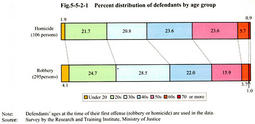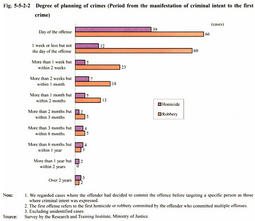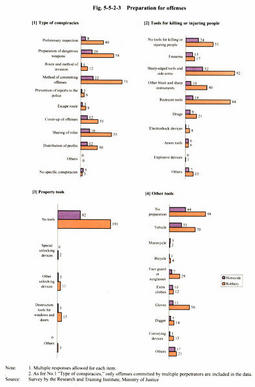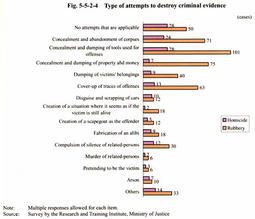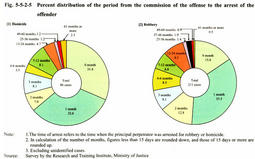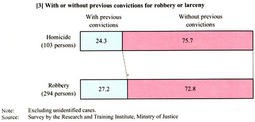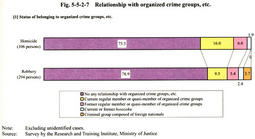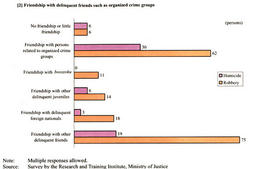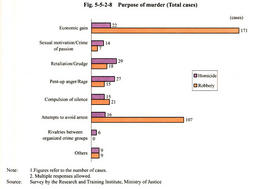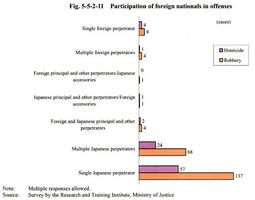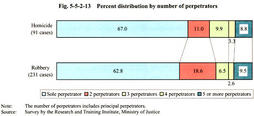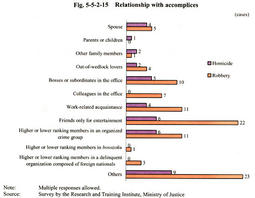| Previous Next Index Image Index Year Selection | |
|
|
1 Analysis based on perpetrators' profile (1) Age group analysis (a) Overview Fig. 5-5-2-1 shows the age groups to which perpetrators (defendants) had belonged at the time of committing offenses.
Imprisonment with labor for life or more severe punishment is demanded by prosecutors in only cases where the correction of the perpetrator is very difficult on the grounds that the case and the perpetrator are considered as extremely vicious. Therefore, there are only a few cases where minors, who are generally flexible and often corrigible, are demanded by prosecutors imprisonment with labor for life or more severe punishment. Regarding groups of young people consisting of persons under 20 and in their 20s, the number of persons who belong to a homicide group was 25, accounting for 23.6% of the total homicide group, and that of persons who belong to a robbery group was 85, making up 28.8% of the total robbery group. On the other hand, the total number of persons in their 30s, 40s, and 50s accounts for a considerably high proportion of each of the total homicide and robbery groups, coming to slightly less than 70% for each. Fig.5-5-2-1 Percent distribution of defendants by age group (b) Escalating young offenders Viewing serious offenses committed by young people, we see that, as in general offenses, many cases where heinous offenses were committed from illogical motivations. In particular, a category of crimes that we could call "an escalating type of offenses " was outstanding among them. This category of crimes is committed by young people who belong to delinquent groups. Such young offenders first, for trivial reasons, falsely accuse victims who have done nothing wrong in particular, punishing them or demanding money or articles. Their acts gradually escalate, and they kidnap and ferry victims around for many hours (in some cases, for many days) in a group. These young offenders continuously use fierce violence against the victims and subject them to tortuous beatings until they die.
Among the cases targeted in the survey, the number of cases that fell under the above category was 8. As for young people, 3 of 22 cases in the homicide group, and 5 of the 55 cases in the robbery group fell under this category. In such cases, the total number of defendants who were demanded by prosecutors a sentence of death or imprisonment with labor for life was 16. In terms of the defendants' age at the time of their offense, the number of persons at the age of 17 or 18 was 2 for each that of persons at the age of 19 was 4, that of persons at the age of 20 or 21 was 2 for each, that of persons at the age of 23 or 24 was 1 for each, and that of persons at the age of 28 was 2. In addition, among these 16 defendants the number of persons with previous convictions (excluding those for professional negligence in traffic accidents, and violation of the Road Traffic Law) was 10. Of them, the number of persons with a history of protective measures was 6, of which 4 had been in juvenile training schools. This data show that not only are there young people who have committed many offenses for their age, but also there are those who committed serious offenses despite having no history of such offenses. The total number of victims who were killed in such cases was 13. Among them, 11 were persons who were 25 years old or less, who belonged to the same age group as the defendants. Regarding whether or not the defendants were acquaintances of the victim, 8 were those who were friends or acquaintances, and 5 were those who were not known to the victim. The above cases all involve accomplices. There are no cases where an offense was committed by a single offender, and the number of accomplices in a case ranged from 3 to 10. The majority of accomplices were young people who belonged to the same age group as the defendants, and many of them were juveniles. Most of these offenses are classified into 2 categories: (1) although the defendants did not intend to kill at first, their intentions became murderous while using violence against victims due to trivial reasons, and then they killed them; (2) while the defendants repeatedly used violence against victims in a group without a clear view or prospect, the victims were severely injured. Since they were at a loss as to how to deal with the injured, the defendants killed them to conceal their violent actions. It has been pointed out that the process of these cases itself shows the mental immaturity of young offenders. In all cases, not only did the offenders kill the victims as a result of fierce violence over a long time, but they also committed, in the course of murder, cruel and brutal acts with the intention of increasing the suffering of the victims. In addition, 6 of the total 8 offenses were deemed to be cases where the offender killed the victim for entertainment. Judgments on such offenses have repeatedly pointed out the barbarity of the defendants' acts, and lack of consideration about the victim being a fellow human being and sympathy about the victim's suffering. After homicide, the bodies of 9 of the 13 victims were abandoned (including 1 of severely injured victim who was buried alive, which resulted in death) by offenders. These include cases where the victim's body was mutilated and abandoned, where the victim's body was transferred from Honshu to Shikoku and abandoned there, and where the victim's body was encased in cement and then buried. The special survey on juvenile robbery offenders, which was described in Chapter 4 , shows that, psychologically, juvenile robbery offenders are greatly influenced by their relationship with their accomplices, and that their criminal acts tend to escalate in line with the involvement of accomplices (see Chapter 4, Section 2 ). Of these 8 serious offenses, there are also some cases where the group mentality, which is particular to young people or juveniles, was seemingly in operation. For example, there is a case where the judge said, "The defendant and his accomplices were incited by each other's violence, and competitively escalated their criminal acts out of vanity, or in other words, the feeling that they did not want to be labeled a `chicken' or a coward." In addition, these serious offenses include 3 cases where the defendants' violence escalated not only in nature but also in quantity, resulting in the murder of multiple victims-a case where 4 victims were killed in 11 days (homicide, and homicide on the occasion of robbery), a case where 2 victims were killed over about 4 months and the principal perpetrator attempted to kill the accomplice of a homicide to prevent it being reported to the police, etc. (homicide, and attempt on the life, etc.), and a case where 2 victims were killed over about 4 months (homicide, etc.). Viewing these 8 serious offenses, we can see the same characteristics as in "bullying" problems, including that assault was initiated for trivial reasons, that multiple offenders relentlessly assaulted a person in a weaker position, that criminal acts were committed for entertainment and with the intention of increasing the victim's suffering, and that offenders sometimes participated in the offense from the motivation that they did not want to be regarded as a "chicken" or a coward. In order to prevent young people from committing such offenses, it is considered necessary for each family and the society to strive to educate children from an early age so that they may acquire the ability to be sympathetic to others' suffering, have the pure sense of justice necessary to know right from wrong and pursue the right, and have the discretion not to succumb to improper invitation. Escalating type of cruel offenses Offenders commit these types of offenses under circumstances where offenders made up a pretext for a fight with victims for trivial reasons, including the reason of becoming irritated at the victim's words or deeds, where the bullying of a person who was in a weaker position in a group of friends was escalating, or where offenders intended to assault someone at random and targeted a passer-by. As for methods of violence, offenders not only punched and kicked victims, but they also used, in most cases, blunt weapons to beat the victims, such as metal baseball bats, metal pipes, wooden swords, and blocks. In addition, when subjecting the victims to beatings, they used cigarette lighters, burning cigarettes, boiling water, knives, saws, ice picks, and thumbtacks, etc, and there were also many cases where victims were sexually assaulted. In terms of the escalation of violence in quantity, there was a case where offenders repeatedly committed offenses, saying to each other "He wants to do it again" and "We did it yesterday and we'll do it today again," and there is another case where offenders subjected a victim to beatings until he died, saying to him, "You're the second." (c) Middle-aged persons who pursue the perfect crime There were cases where middle-aged persons, who account for the majority of total serious offenders, committed a thoughtless, impulsive crime as young people. Meanwhile, we can also find many cases where middle-aged persons committed the well-prepared offenses that young people cannot imitate. Many of such offenses are not perfect, but they are very well-planned.
To examine the situation of such offenses, we developed the following indicators of a perfect or well-planned crime: (1) criminal intent has been expressed from the early stage; (2) in the case of offenses committed by multiple offenders, there were any conspiracies between or among them; (3) the offense had been well-prepared; (4) criminal evidence was thoroughly destroyed; (5) a long period had elapsed by the time the offense was exposed and the offender was arrested. Then, we examined all of the cases targeted in the survey in light of the above 5 key concepts. Fig. 5-5-2-2 shows the period from the manifestation of criminal intent for homicide or robbery to the time when the first offense was initiated, by case. The majority were cases where offenders who committed serious offenses, such as homicide and robbery, expressed their criminal intent on the day of committing offenses. Meanwhile, there are also quite a few cases where there were facts clearly suggesting that the offender had planned the offense in advance, including the fact that criminal intent had arisen prior to the day before the commission of offenses. In particular, it should be noted that many offenders had had criminal intent 1 month or more prior to committing homicide or robbery. Fig. 5-5-2-3 shows the type of conspiracies and preparations for committing offenses, by case. Most offenses committed by multiple offenders include conspiracy between or among them. Various types of conspiracy exist, among which there are cases where offenders had even discussed cover-ups and the escape routes they would need after committing offenses. Regarding the preparation of tools for killing or injuring people, restraint tools are often used in robbery because many cases of robbery place top priority on the seizure of money or articles. In addition, there are some cases where stun guns, drugs (tools for causing unconsciousness), and arson tools, including gasoline, were prepared. In contrast, there are only a few cases in robbery as well as homicide, where the property tools, including unlocking devices, were prepared. One reason for this trend is that this type of serious offenses is well-planned, and targets places that are not well-locked. Another reason is that offenders are often friends or acquaintances of victims, and can easily enter their apartments to commit serious offenses. As other preparations, many offenders prepare cars, gloves so as not to leave fingerprints, and items to conceal their face or clothes. In addition, there are cases where the offender, who had planned to kill the victim, prepared diggers so as to transfer and abandon the victim's corpse, etc. Fig. 5-5-2-4 shows the types of attempts to destroy criminal evidence. In many cases, offenders conceal and destroy the tools used for the offense and the money or articles robbed, abandon the victims' corpses, or conceal traces of the crime, such as bloodstains and fingerprints. In several cases, offenders made vicious or elaborate attempts to destroy criminal evidence. These attempts include disguising or scrapping the vehicle used for the offense, arson so as to destroy the evidence, compulsion of silence of related persons through intimidation or the murder of related persons, creation of a scapegoat as the offender, and fabrication of an alibi. If attempts to destroy criminal evidence are carefully made, not only detecting the offense but also arresting the offender will be delayed. Fig. 5-5-2-5 shows the period from the first crime committed by defendants (principal perpetrators) to the time they were arrested for robbery or murder, by case. Even in the case where the offense was well-prepared, 64.0% in the homicide group and 51.2% in the robbery group had been arrested within 1 month, and 82.6% in the homicide group and 80.6% in the robbery group had been arrested within 6 months. This data suggests that the investigating authorities are quite active and strict in working on serious offenses. On the other hand, there have been a few cases where the offender has not been arrested for more than 1 year after the crime: 9.3% (8 cases) in the homicide group and 12.8% (27 cases) in the robbery group fall into this category. These cases include homicide for insurance money disguised as accidental death, a series of robbery or rape on the occasion of robbery committed in a professional manner, the homicide or homicide on the occasion of robbery where the victim's corpse was well-concealed by burying it or taking other measures. We established the following 4 requirements of vicious, well-planned offenses: (1) criminal intent was not manifested at the day of the offense; (2) a certain tool for killing or injuring people had been prepared; (3) certain destruction of criminal evidence was done; (4) 1 month or more had elapsed by the time the offender was arrested after committing the crime. The number of cases that meet all of the above 4 requirements accounts for 33.0% (30 cases) of total homicide cases and 43.7% (97 cases) of total robbery cases, among which the number of cases committed by middle-aged persons in their 30s, 40s, and 50s makes up the majority, coming to 25 for homicide and 78 for robbery. Among them, the number of offenses committed in a sophisticated manner and with thorough destruction of evidence, or in other words, offenses designed to be the perfect crime, was 11 for the homicide group (of which 9 were for homicide for insurance money, and each 1 was for the offense aimed at escaping liability and the rivalry between organized crime groups), and 10 for the robbery group. This data shows that unlike juvenile offenders, many middle-aged persons who have social experience commit homicide or homicide on the occasion of robbery based on a well-made plan, mainly so as to gain economic profits. Offenses for insurance money that were designed for perfect crimes There was a case where 2 bill brokers targeted a victim who had been uncomfortable with the demand to repay debts by a money broker, and then planned a homicide for insurance money. They persuaded the victim to concoct a fake marriage, claiming that such marriage would be helpful for silencing his creditors. Their fake marriage scheme was successful, and the victim concocted a fake marriage to a woman who went along easily with the plan in return for financial reward. One of the 2 bill brokers pretended to be the victim to enter into a life insurance contract, and prepared an officially authenticated instrument describing a contract to repay enormous debts. In the instrument, the victim was regarded as a debtor, and his wife as a bondswoman. Then, these brokers disguised a traffic accident, running over and killing the victim. However, since their offense was exposed before accomplishing the insurance money fraud, they were not actually able to get the insurance money. Other than this case, there are also many cases of homicide for insurance money where offenders took advantage of the victims' poverty to control them, making various attempts to disguise the reality of killing them: Among them, there is a case where the offender, who had gained insurance money amounting to hundreds of millions of yen after the success of a homicide for insurance money, tried to kill another victim in order to accomplish the fraud of a larger amount of insurance money. Fig. 5-5-2-2 Degree of planning of crimes (Period from the manifestation of criminal intent to the first crime) Fig. 5-5-2-3 Preparation for offenses Fig. 5-5-2-4 Type of attempts to destroy criminal evidence Fig. 5-5-2-5 Percent distribution of the period from the commission of the offense to the arrest of the offender (2) Serious offenses committed by a previously convicted person Fig. 5-5-2-6 shows the total number of previous convictions ("previous convictions" includes criminal histories in this subsection (2).) of the survey targets, and whether or not they have previous convictions for offenses of the same kind. As for the total number of previous convictions, first-time offenders account for more than 50% in the robbery group, and offenders with many previous convictions make up a smaller proportion in the robbery group than in the homicide group. Regarding previous convictions for offenses of the same kind, persons with previous convictions for either offenses involving killing or bodily injury (homicide, bodily injury, and bodily injury resulting in death) or violent crimes (extortion, intimidation, destruction of objects, and assault) account for 31.7% in the homicide group, which is a higher percentage than 22.3% in the robbery group. Persons with previous convictions for robbery or larceny account for 24.3% in the homicide group, which is relatively similar to the 27.2% in the robbery group. This data shows that first-time offenders account for a considerable proportion of the total offenders who committed serious heinous offenses, and persons with no previous convictions for offenses of the same kind account for about 70%.
Fig. 5-5-2-6 Percent distribution of total number of previous convictions and whether or not offenders have previous convictions for offenses of the same kind (3) Serious offenses committed by offenders related to organized crime groups, etc. (a) Overview Fig. 5-5-2-7 shows the status of belonging to delinquent groups, including organized crime groups and motorcycle gangs, known as bosozoku, that cause disturbances and acts of violence, etc., as well as the association with delinquent friends such as organized crime groups. The number of persons related to organized crime groups or bosozoku was 26 (24.5%) in the homicide group, and 51 (17.3%) in the robbery group. The number of persons who were friends with persons related to organized crime groups was 30 in the homicide group, and 62 in the robbery group, while the number of cases involved by organized crime groups or bosozoku was 18 in the homicide group, and 32 in the robbery group.
Fig. 5-5-2-7 Relationship with organized crime groups, etc. (b) Rivalries and the pursuit of profits Fig. 5-5-2-8 shows the breakdown of purposes of murder in all of the cases targeted in the survey, and Fig. 5-5-2-9 shows the breakdown of purposes of murder in the cases involved by persons related to organized crime groups or bosozoku.
The number of offenses committed for economic gain was the largest among all cases targeted in the survey. The number of offenses committed "to avoid arrest," which was a typical purpose in homicide on the occasion of robbery, was the second largest, while that of offenses committed for other purposes was small However, as for 50 cases involving persons related to organized crime groups or bosozoku, the number of offenses committed for purposes particular to organized crime groups, including retaliation, grudge, pent-up anger, rage, the compulsion of silence, and rivalries between organized crime groups, was relatively larger than in total cases targeted in the survey. As for the dangerous weapons used by such offenders, firearms were used for 18 cases, of which 17, the majority, were cases where offenders shot victims to death (Of the total cases, firearms were used for 25 cases, and shooting to death for 22 cases). In this way, many cases are highly likely to cause concern in society in general More specifically, of the 50 cases involving persons related to organized crime groups or bosozoku, only 6 concerned rivalries between organized crime groups, arising from fights over territory, etc. In contrast, the number of cases committed to gain money or profits was quite large, coming to 32 for robbery and 3 for homicide for insurance money. Among them, there are cases where persons related to organized crime groups committed a series of robberies, robbery of proceeds from the sale of illegal drugs, and even robbery of a person related to another organized crime group. This suggests that organized crime groups aggressively pursue profits. Robberies committed by organized crime group members against other organized crime group members There was a case where an organized crime group leader planned to visit a leading member of another organized crime group, whom he came to know in prison, with his subordinate to request a loan. The crime group leader had intended to rob the victim of money by intimidating him at gunpoint if he had refused to lend the money. While the crime group leader and his subordinate were intimidating the victim, his subordinate shot the victim to death. This incident shows that even a person who occupies a high position in an organized crime group can attempt to rob a leading member of another organized crime group of money, by threatening them at gunpoint. It seems that the recent increase in robberies committed by persons related to organized crime groups has been caused partly by the exhaustion of the traditional fund sources of organized crime groups. Fig. 5-5-2-8 Purpose of murder (Total cases) Fig. 5-5-2-9 Purposes of murder in cases involved by persons related to organized crime groups, etc. (Total cases of homicide and robbery) (4) Cooperation between visiting foreign nationals and organized crime groups Table 5-5-2-10 shows the number of persons of foreign nationality who were targets of the survey. The number of offenses committed by persons of foreign nationality was small, 8 (7.5%) for the homicide group and 28 (9.5%) for the robbery group. The majority of them were committed by illegal entrants and overstayers. Fig. 5-5-2-11 shows foreign nationals' participation in offenses. Twenty-six cases were committed by only foreign nationals or jointly committed by foreign nationals and Japanese. Among them, 5 cases were committed by gangs of robbers or thieves of foreign nationality, of which 2 were cases of robbery resulting in death where such gangs of visiting foreign nationals and organized crime groups jointly invaded houses to commit robbery, and then killed the victims. These cases suggest that gangs of foreign nationals and organized crime groups repeatedly commit robbery and larceny, individually or in cooperation with each other, depending on the circumstances. The number of foreign nationals who enter Japan has been increasing, and is highly likely to continue to increase in conjunction with the advance of globalization in Japanese society. Serious offenses punishable with death or imprisonment with labor for life, committed by domestic and overseas criminal groups that repeatedly commit crimes, such as gangs of foreign nationals and organized crime groups, have emerged under such circumstances. We need to focus on the trend in such offenses because they provide a definitive indication of the negative side of globalization and have a major impact on peace in civil life.
Table 5-5-2-10 Nationality of defendants Fig. 5-5-2-11 Participation of foreign nationals in offenses Cases where a criminal group of visiting foreign nationals and an organized crime group worked togetherA gang of robbers and thieves, consisting of a Japanese organized crime group and another gang of robbers and thieves consisting of foreign nationals who smuggled themselves into Japan, jointly repeated offenses of robbery and larceny, among which there was 1 case where the victim was killed. They obtained the information they need to commit their crimes from informants and targeted, using well-made plans, only houses where a large amount of money or articles were likely to be found. In these cases, they used various tools, including drugs such as chloroform, as well as stun guns and packing tape. They committed many offenses across several prefectures, robbing money or articles totaling 300 million yen or more over about half a year. Their criminal acts were thus very well-planned and committed in a professional manner. (5) Rampancy of professional gangs of robbers, etc. (a) Professional gangs of robbers who are active behind the scenes Table 5-5-2-12 shows the number of offenses of homicide and robbery that were carried out, by case. The number of cases involving 3 homicides or more was 20, which is quite large. Most of them were committed on the same occasion or in a series of connected occasions, as seen in cases committed by phantom killers or knifers, and a few were committed on different occasions. The number of cases involving 3 robberies or more was 26. Most of them were committed by serial robbers on different occasions. In addition, the number of cases committed by habitual offenders who repeated offenses of robbery and larceny was 29, which indicated the existence of professional groups of habitual offenders.
Fig. 5-5-2-13 shows whether or not accomplices were involved in homicide or robbery and the number of such accomplices. The accomplice rate (rate of the number of cases involving 2 or more perpetrators to the total number of cleared cases) was 33.0% for homicide cases and 37.2% for robbery cases, which are both considerably higher than in general cases of homicide and robbery (as for adults, 6.7-9.6% for homicide, and 15.3-26.5% for robbery). Among cases targeted in the survey where defendants were demanded by prosecutors a sentence of death or imprisonment with labor for life, there are some cases where perpetrators planned to jointly commit heinous homicide, such as homicide for insurance money and lynching murder, in a group. Moreover, there are many cases where the victims' bodies were buried or mutilated to destroy evidence. It is difficult for a single perpetrator to commit offenses of this kind. Other than the above, there are not only cases where multiple perpetrators jointly commit robbery and larceny to prevent the discovery of offenses, but also those where professional gangs of robbers and thieves, characterized by higher organizing power, committed offenses. The higher rate of offenses committed by multiple perpetrators is apparently due to the existence of the above cases. Additionally, among the target robberies of the survey, 9 cases were committed by professional gangs of robbers and thieves. Fig. 5-5-2-14 and Fig. 5-5-2-15 show the background of participation in offenses and the relationship of the perpetrators. As for robbery, perpetrators participate in offenses for economic gain, such as shared profits. Various types of relationships exist between or among perpetrators, and the number of cases where perpetrators came to know each other at their workplace or in their work was large, and the number of cases where perpetrators committed offenses with family members other than their spouse was small. In addition, there are many cases where multiple perpetrators, who belonged to the same organized crime group, bosozoku, or delinquent group composed of foreign nationals, jointly committed offenses. Since this type of connection of perpetrators leads to the development of activities of professional gangs of robbers and thieves, we need to focus on its trend. Table 5-5-2-12 Number of homicides and robberies Fig. 5-5-2-13 Percent distribution by number of perpetrators Fig. 5-5-2-14 Background of participation in offenses Fig. 5-5-2-15 Relationship with accomplices Gang of robbers using handgunsThere was a case where 2 former organized crime group members committed a series of robberies targeting financial institutions, including cash delivery vans and pawnshops, together with an acquaintance. They committed these offenses using handguns. Although they did not kill anyone, they committed 5 attempted homicides on the occasion of robbery by shooting the victims with handguns, robbing an amount of money totaling 300 million yen or more across multiple areas. As a result, they caused great concern in the society. (b) Series of rapes on the occasion of robbery Rape on the occasion of robbery is one of the most heinous offenses. The offenders who committed this type of offenses are likely to escape arrest, because a sense of shame causes many female victims to remain silent. This means that the rape on the occasion of robbery has a higher possibility of being unreported to the police, etc, than other types of robbery. In addition, women who live on their own are often targeted, which makes it difficult to expose the offenses. Therefore, there are habitual offenders who repeatedly commit offenses of this kind. According to the Table 5-5-2-12 mentioned above, of total cases targeted in the survey, the number of rapes on the occasion of robbery was 23, among which 9 cases were committed by habitual offenders who had committed rape on the occasion of robbery 3 times or more. Among them, 3 cases were offenses involving further crimes, such as homicide, homicide on the occasion of robbery, and robbery resulting in death. The other 6 cases did not include such crimes, but a sentence of imprisonment with labor for life was demanded for the offenders by prosecutors on the grounds that they were extremely vicious habitual offenders, of which 5 were cases where they were so sentenced as demanded. This trend shows that it is necessary to keep an eye on this type of series of rapes on the occasion of robbery.
Series of rapes on the occasion of robbery There was a case where an overstaying foreign national targeted unmarried women who lived on their own, committing rapes on the occasion of robbery many times over a period of about 2 years. He stayed in the victims' houses for a long time, intimidating them and taking pictures of their naked bodies to prevent them from reporting the incident to the police, etc. He earned his living by committing robbery. Other than this case, there are many cases where Japanese habitual offenders repeatedly committed rape on the occasion of robbery, by causing unconsciousness in victims using sleep-inducing drugs. |
